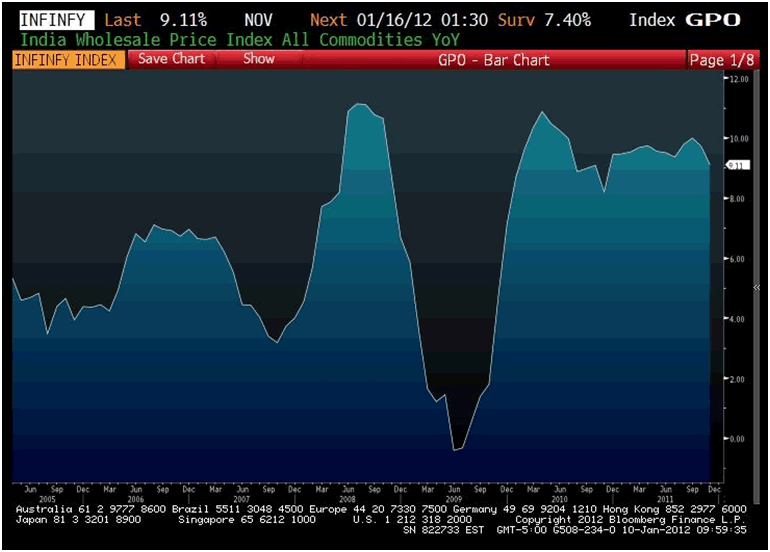India Economy 2012: What to Expect
Economics / India Jan 18, 2012 - 11:36 AM GMT

 The political situation in India remains murky, and elections will be held in key states early this year. Uttar Pradesh, the country’s most populous state, will hold elections in seven phases, which will unfold during most of February. Punjab, a significantly smaller state in terms of population, will also hold elections in January and March.
The political situation in India remains murky, and elections will be held in key states early this year. Uttar Pradesh, the country’s most populous state, will hold elections in seven phases, which will unfold during most of February. Punjab, a significantly smaller state in terms of population, will also hold elections in January and March.
In these and other states, the Indian National Congress, India’s ruling party, faces serious opposition, and further dramatic developments cannot be ruled out if it does not perform well.
On the economic front, inflation, which is around 8 percent, remains a serious issue for India, persisting in a manner that few of its policymakers had anticipated. While food inflation has fallen to levels below 8 percent from its recent high of 20 percent, inflation in non-food manufacturing has risen 8 percent from 3 percent.
Early last year, food inflation was a major concern, so inflation’s shift in momentum toward non-food manufacturing has surprised policymakers. Some analysts attribute this development to the government’s pursuit of initiatives to support rural employment and guarantee prices for certain agricultural products.
One example of these policies is the Mahatma Gandhi National Rural Employment Guarantee Act, which aims to enhance “the livelihood security of people in rural areas by guaranteeing a hundred days of wage-employment in a financial year to a rural household whose adult members volunteer to do unskilled manual work.” Another policy is the Minimum Support Price which requires government to purchase agricultural produce from farmers at a fixed price regardless of market conditions.
These efforts to affect a redistribution of income have had an inflationary outcome. That forced the Reserve Bank of India, the country’s central bank, to tighten monetary policy last year in an effort to curtail the problem.

Source: Bloomberg
At the moment, economists do not expect India to exceed gross domestic product (GDP) growth of 7 percent this year. If the country’s chaotic electoral politics continue to dominate the headlines for much longer, the resulting uncertainty could cause economic growth to come in closer to 6 percent. And if investors begin to worry that economic growth is at risk, the Indian stock market could rapidly decline by 20 percent to 30 percent.
But before that happens, India’s central bank will likely take steps to support the economy by lowering interest rates. Such action should be beneficial to the economy by spurring new loan activity. Annual growth in loan demand has fallen to 16 percent from more than 30 percent a few years ago.
If inflation continues to dampen and growth remains weak, the central bank could cut rates by the end of the first quarter. In the short term, India’s stock market should react positively to such an action.
Regardless of the present headwinds, India’s strong domestic demand story means that it remains an attractive investment destination for the long-term investor.
Furthermore, the Bombay Stock Exchange Sensex trades at around 2 times book value, which is significantly lower than its long-term average of 3.2. That offers fundamental support at current levels.
For now, I suggest hedging exposure to India via iShares MSCI BRIC Index(NYSE: BKF), whose portfolio also covers Brazil, Russia and China.
By Yiannis G. Mostrous
Editor: Silk Road Investor, Growth Engines
http://www.growthengines.com
Yiannis G. Mostrous is an associate editor of Personal Finance . He's editor of The Silk Road Investor , a financial advisory devoted to explaining the most profitable facets of emerging global economies, and Growth Engines , a free e-zine that provides regular updates on global markets. He's also an author of The Silk Road To Riches: How You Can Profit By Investing In Asia's Newfound Prosperity .
© 2005-2022 http://www.MarketOracle.co.uk - The Market Oracle is a FREE Daily Financial Markets Analysis & Forecasting online publication.


